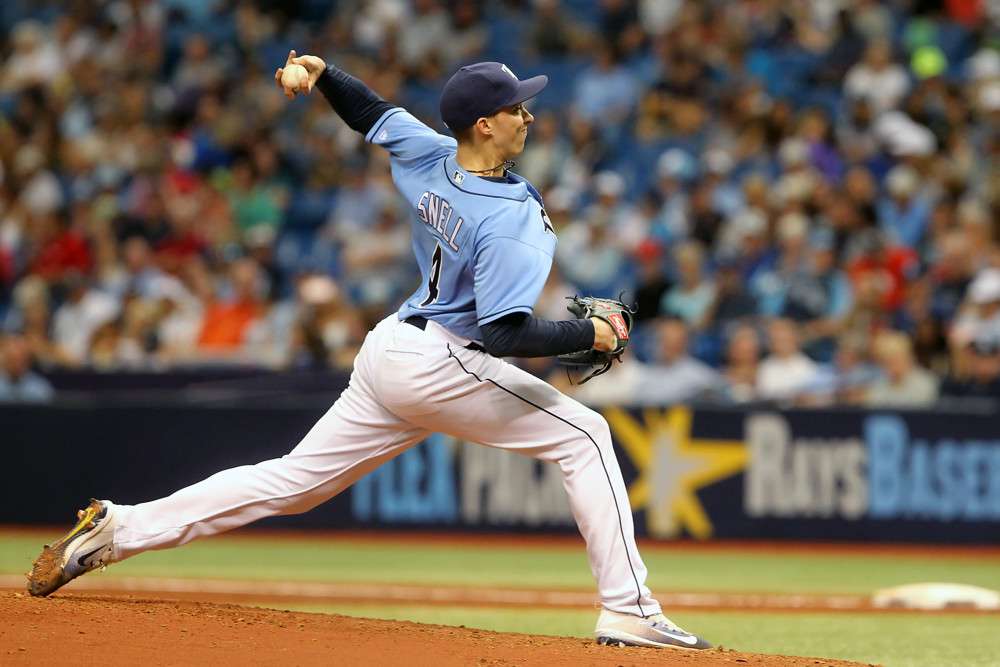
With spring training getting underway, the 2018 fantasy baseball season is very nearly approaching. Each week, I will be evaluating one player’s stock for this year. This week, a player who used to be one of baseball’s best pitching prospects, and who tapped into his upside in the second-half last season thanks to a dramatic uptick in the quality of his stuff and an emerging offspeed pitch.
Join or start a fantasy baseball league at Fantrax today! Keeper, dynasty, re-draft. Fully customizable. A+ customer service. Play for free!
Blake Snell, Tampa Bay Rays
2017 statistics: 129 innings pitched, 4.04 ERA, 4.19 FIP
General Overview
After a stellar 2015 season in the minors, Blake Snell entered 2016 as Baseball America’s number 12 overall prospect. After starting 2016 with a dominant performance in Triple-A, Snell finished that season in Tampa, where he tossed 89 innings with a 3.54 ERA and an above-average 24.4% strikeout rate. All the hype seemed to evaporate in the first half of last season, when Snell issued 25 walks in 42 innings, posting a 4.71 ERA before he was optioned back to Durham. From that point on, however, things turned around, as he followed up a dominant seven-start cameo with the Bulls with a very strong 87.1 innings following his return to the majors. Still, perhaps due to a combination of prospect fatigue and the fact that his strong start was in relative obscurity, Snell is not being viewed highly by fantasy owners, being selected 60th on average among starting pitchers in drafts to this point. At his current ADP, owners are getting a steal.
Second-Half Breakout
Snell was recalled from Durham on June 28. From that point forward, he posted an above-average strikeout rate (23.7%), and he trimmed his walk rate from an untenable 13.2% prior to his demotion to a passable 9.5%. As Fangraphs’ Jeff Sullivan noted back in November, Snell curiously cut back on the walks while working less often than ever in the strike zone. Instead, as Sullivan noted, Snell was having ample success getting opposing hitters to chase out of the zone, which would most easily be explained by an improvement in stuff. Indeed, Snell’s stuff was up across the board relative to his first major-league stint. Most notably, Snell’s fastball picked up a tick, while his curveball spiked nearly three miles per hour. In addition to the velocity bump, Snell’s curveball also saw a significant uptick in spin rate. As Mike Petriello once noted, curveball spin is useful for inducing ground balls, which could be a particularly noteworthy development for Snell given the strong offenses that he will be tasked with facing this season. Not coincidentally, he began to rely on that pitch a bit more often near the end of the year, culminating with his final performance of the season. On October 1 against Baltimore, he threw 19 curveballs, his highest rate of the year, and he induced nine whiffs on the pitch, striking out 13 hitters in the best start of his career. The curveball became a legitimate weapon for Snell down the stretch, and, when coupled with a harder fastball, it is easy to see why hitters were more often reaching for pitches out of the strike zone.
Concerns
While Snell looked like a legitimately different pitcher in the second half of last season, there is no guarantee that he can sustain such a performance. He has not demonstrated that he can hold that improved stuff over the course of a full season, and his awful first half cannot simply be washed away. Snell has struggled with his command at the big-league level, and even his second-half walk rate was more tolerable than good. As noted, he also made his living inducing chases outside of the strike zone, a tightrope which can be tough to walk consistently, as Francisco Liriano can attest. Further, as a left-handed starting pitcher in the AL East, Snell will be in for some difficult assignments, facing lineups loaded with right-handed power hitters. However, his changeup and improved curveball make him decently equipped to deal with opposite-handed hitters, and while his surface numbers would suggest dramatic platoon splits, his batted ball quality and control of the strike has actually been pretty similar regarded of the opposing hitter’s handedness.
2018 Outlook
Entering his age-25 season, Blake Snell offers some very exciting upside next year, upside that is not currently being reflected in his average draft position. Despite a seeming mixed reputation, he has over 200 career innings with an ERA and FIP below 4.00, and his most recent run of performance was undoubtedly his strongest, bolstered by a legitimate improvement in the quality of his stuff. Fangraphs’ Depth Charts project Snell to post a solid 3.75 ERA with 167 strikeouts next year, significant upside for a player currently being selected after Cole Hamels and Lance Lynn. If Snell’s spike in quality of stuff is indeed sustainable (and scouts have long pegged Snell as having #2 starter upside), he may be a top-25 starting pitcher by next season. The projections are, after all, reluctant to buy into any potential breakout, and yet they anticipate that, on average, he will still look something like a quality #3 starter, even if his stuff regresses to prior levels. Based on both ceiling and floor, Snell should be coming off the board well before the 215th pick moving forward.
2018 Player Profiles
